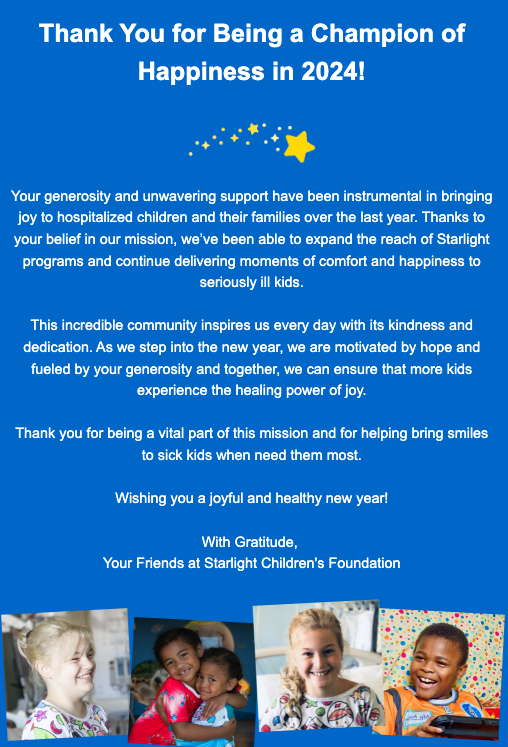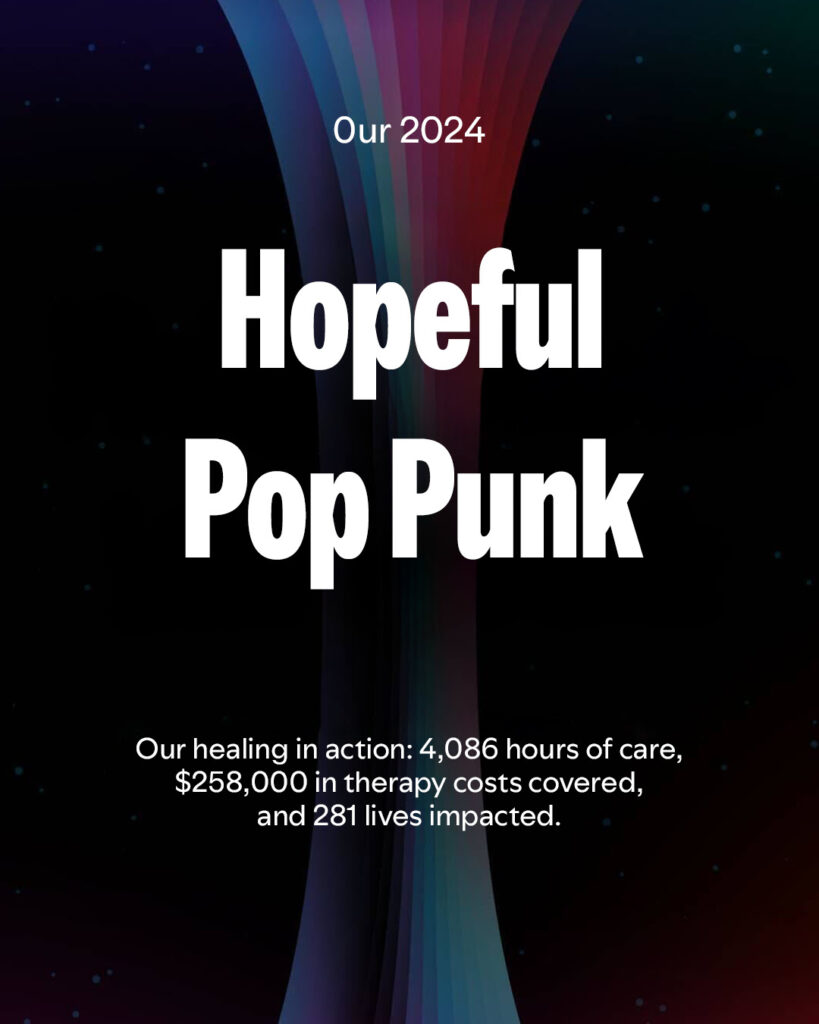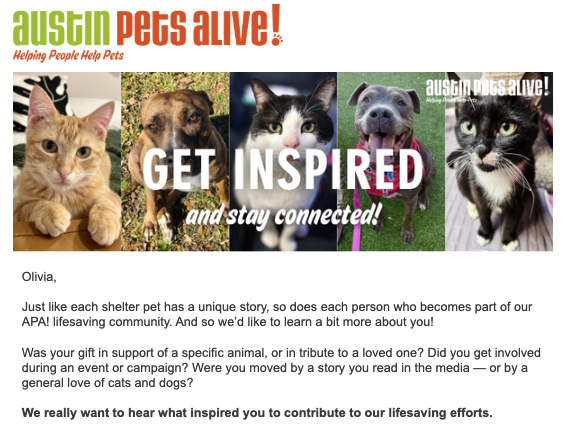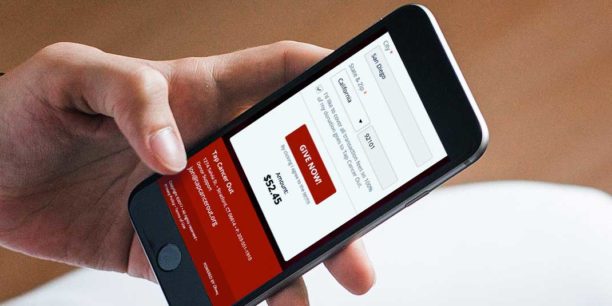15 Creative Ways to Write Meaningful Donation Thank-You Letters

The power of a donor thank-you letter is undeniable. Whether as a touchpoint after your year-end campaign or as a check-in following your spring event, personalized thank-you letters help donors feel valued.
Building donor loyalty through gratitude often pays off in more recurring donors, volunteer support, and corporate sponsorship opportunities. So how do you craft memorable thank you’s?
Below, we’ll walk through a comprehensive guide on how to transform standard thank-you letters into pivotal moments that create lasting relationships. We’ll cover reasons why you should thank your donors and what makes a good donor thank-you letter, along with creative ideas and samples to get you started.
Why donation thank-you letters are essential for nonprofits
When investing in a thank-you strategy, it helps to articulate its impact on your team. This gets your staff, board members, and other stakeholders aligned on the effort. Opting for an attitude of gratitude helps:
- Create deeper connections with your donors. The key to effective donor stewardship is ensuring each supporter finds value and belonging in their relationship with your nonprofit. Showing you care about people as individuals, regardless of their giving capacity, builds trust and a deeper connection.
- Keep your mission top of mind. Regular communication with donors boosts visibility. When you reach out to say thank you, you also keep your cause on supporters’ radar.
- Encourage donors to give again. The giving experience extends beyond the transaction—it’s about how donors feel afterward. Showing them the immediate impact of their contribution can inspire future action. Thanking donors is a valuable way to keep your community connected and engaged before, during, and after each campaign.
What makes a good donor thank-you letter?
Your thank-you note reinforces the passion and emotion that drove someone to donate while thanking them for their dedication. Here are some considerations that influence donors’ continued support.
1. Timing
Timing is key when saying “thank you.” You want your supporters to feel valued, so avoid sending a generic thank-you note that arrives days or weeks after their moment of impact has passed.
Donors should receive an automatic online donation receipt immediately following their donation confirming the gift amount. Shortly afterward, you should follow up on the receipt with a personalized “thank you for your donation” message.
Automation, a solid customer relationship management (CRM) integration, and a thoughtful message can help you retain passionate or first-time donors without overwhelming your to-do list.
2. Content
Donors want to feel involved beyond their donations. Your thank-you note opens the door, inviting them to engage with your nonprofit, feel invested in your fundraising results, and connect meaningfully with your mission.
Whether new donors or existing advocates, celebrate what each individual helped you accomplish. But be careful not to build an experience that feels like another tax receipt or donor contribution summary. This is your opportunity to tell your story and show supporters how they help bring your mission to life.
When you highlight the campaign or project someone specifically supported, you help donors see and feel the real-world implications of their gift. If possible, feature a specific community, place, or person they’ve helped. For inspiration, use Classy from GoFundMe’s fundraising email templates.
3. Tone
It’s not only what you say but also how you say it. While your donation request letters and formal appeals may benefit from tones of sympathy or urgency, a thank-you letter should have a celebratory and uplifting feel.
Thank-you letters are a chance to make the donor feel good about their decision and show that their generous gift makes a difference. While you can still note the urgency or seriousness of your cause, this message should be one of hope and action.
15 ideas for how to better thank nonprofit donors
When putting together your thank-you strategy, consider donors’ communication preferences and any seasonal factors, like whether this is a general thank-you for a great year versus following up on a specific campaign. Here are 15 thank-you ideas for engaging your supporters, including real-world nonprofit examples.
1. Show appreciation on your website
Your nonprofit’s website is an excellent platform for donor and volunteer appreciation. Dedicating space on your site to spotlight your community members shows strong regard.
Use supporter pages, blog posts, newsletter features, and leaderboards to celebrate the people who make a difference for your mission daily. Putting faces and names to the impact you achieve supports donor retention and acquisition efforts while showcasing your organization’s success.
2. Align your thank-you message with your brand
Keeping your thank you’s consistent with your nonprofit branding helps strengthen donors’ connections to your cause. These messages of gratitude are an opportunity to communicate your vision and help donors quickly recognize your work when they see it through various channels.
Starlight Children’s Foundation is a great example of this. The nonprofit’s mission is to deliver happiness to hospitalized children and their families. Happiness is a core driver for the nonprofit’s programming and something it wants to keep front and center for donors.
In their end-of-year thank-you emails, the Starlight Children Foundation’s team does this by referring to donors as “champions of happiness” and featuring a photo of a smiling patient. This clear messaging quickly reconnects donors to the cause and reminds them why they gave—and should give again.

3. Highlight donors on social media
What better place to express gratitude for generous donations than where people are most likely to see and reshare it?
Appreciation posts provide great content to add to your seasonal social media calendar. Even if you don’t name specific donors, you can share a general thanks with impactful statistics about what your community accomplished together.
If you highlight individual donors, ask if they prefer you use their full name, tag their social media accounts, or keep it to only their first name and last initial for privacy.
4. Craft a personalized thank-you email
Gone are the days of impersonal salutations, like “Dear friend” or “Dear Mr.” Technology has advanced significantly, making it easier to balance personalization and branded appeals that leave a strong impression on recipients.
Consider how your message might change when factoring in a donor’s gift size, generation, location, giving frequency, personal preferences, or engagement patterns. These personalized elements can help your message go from another email in someone’s inbox to a reminder of how good it feels to support an organization that genuinely cares.
To Write Love On Her Arms is one personalized thank-you email example we love. The organization continues to evolve its outreach around popular trends like the famous Spotify Wrapped list to show donors they’re worth a big display of appreciation.

5. Lean into authenticity with a thank-you video
A donor thank-you video is a powerful tactic to show supporters who’s behind the messages they’ve received. This engaging format can help make a lasting impression through email, social media, website, or campaign pages.
Friends of Bonobos, which rescues bonobos and protects their rainforest homes, created a short video with several of its international staff saying thank you in different languages and expressing how much donor support means to them. The video also features adorable footage of bonobos with their caretakers. The nonprofit embedded this video into a thank-you email.
6. Pick up the phone or send a text
Imagine a donor receiving a call from your team after an event to personally thank them for attending. Or maybe they see a text checking in on how their weekend was and sharing a spontaneous thank-you for being a member of your community. These are both opportunities to connect with that person in a more relaxed, organic way.
On your donation forms, ask for donors’ phone numbers and include an opt-in to calls or texts from your organization. This small interaction can make a donor’s day and help build a lasting connection.
7. Send donation thank-you letters (yes, real letters!)
The rarity of direct mail and handwritten notes makes it even more special to connect with donors in this way after a big donation or milestone. What if you followed up on your emails, texts, or calls with personalized letters from your leadership team?
Since your mail will arrive a while after a charitable donation, stewardship letters to donors can serve as the perfect touchpoint to re-engage them with a reminder of their impact. If you have their postal and personal contact information, give this one a try.
8. Celebrate anniversaries
Your donors’ anniversary of their first gift is a great time to say thank you outside of a transactional email. Get creative here to celebrate their involvement and show that their presence is felt at your organization even when it’s been a while since their last interaction.
CRM or donation management tools can help you track a donor’s first gift and automate a thoughtful thank-you message that touches on their actions throughout the year. A physical or online anniversary card is a fun way to celebrate their loyalty and commitment to your cause.
9. Celebrate donors in your annual report
It’s common for organizations to include a running list of donors and sponsors in their nonprofit annual reports. Consider how you can use that list to emphasize each donor’s critical role in fulfilling your mission. Send donors a physical letter to thank them, along with a printed copy of the report or a digital copy when it’s ready, to let them know they’re part of something bigger.
Also, consider how to promote the report to your larger community to elevate your loyal and committed donors even more. When others see a familiar donor’s name listed in your report, it may inspire them to give and join the community.
10. Put a face to your message
Your thank-you messages are an opportunity to remind supporters about your cause and the impact of their gifts. One powerful way to do this is by including a photo of a beneficiary and a personal note of thanks from them. This adds a personal touch and reinforces the difference they make.
Ready, Willing & Able helps people experiencing homelessness gain needed support and services for brighter futures. In a thank-you email, the nonprofit included photos of three people it served alongside quotes from each saying what the help meant to them. This example reiterates how the donor’s generosity made this possible.

11. Send a welcome swag package
We all know how exciting a simple T-shirt or branded swag item can feel when you least expect it. So why not leverage that excitement in your donor appreciation efforts? A thank-you package can help welcome new donors in style. This package could include apparel, a water bottle, a canvas tote, stickers, and resources to learn more about your organization.
Additionally, when you give out brand merchandise that creates a natural Instagram or TikTok unboxing moment, you might encourage donors to share photos or videos of their swag online.
12. Acknowledge donors during events
Your next fundraising event is a timely opportunity to recognize major donors or individuals who created a big impact. Invite them to stand up and be celebrated by all attendees or speak about their experience with your organization.
But before publicly recognizing donors at your next event, ask whether they’re comfortable being honored in front of an audience. If they decline, have your staff thank them privately at the event. You could also send them a free ticket as an alternative form of appreciation and ask for testimonials to share instead.
13. Share exclusive incentives
Nonprofit donors typically don’t give to get something in return. At the same time, providing incentives doesn’t hurt in converting more donations and bringing people back to give again.
To keep things organized, create giving levels to thank donors with specific items or opportunities matching their gift size. This presents another opportunity to share some swag with your community so they can publicly promote their support of your cause.
14. Focus on donor retention
A spontaneous thank-you message long after someone has taken action is a great way to support donor retention. Send messages to thank donors for sticking with you and reiterate how their continued support positively impacts your mission.
Strong data on donation activity, giving levels, and recurring donation history will help personalize your messages and acknowledge past generosity. Your fundraising strategy should also always include multiple opportunities to follow up and inspire donors to give again.
15. Weave in another call to action
Your thank-you messages can also introduce the next step in your relationship with a donor. Where appropriate, use a donation or event follow-up to invite supporters to the next opportunity to get involved.
Offer a simple call to action, like signing up for your nonprofit newsletter or following you on social media. By staying in touch, you may be able to secure your next major gift, turn a one-time donor into a recurring donor, and grow your donor retention rate.
Austin Pets Alive! used a moment of gratitude in an email to engage supporters. The message asked, “What inspired you to help shelter pets?” Then, it asked whether the supporter gave the donation to support a specific animal, as a tribute to a loved one, or for another reason.
The nonprofit encourages donors to remain engaged by asking them for their feedback and stories, including photos of their pets. This approach leaves the supporter feeling valued and appreciated while gathering valuable feedback and information for the nonprofit to use for future campaigns and stewardship.

Nonprofit thank-you letter templates to inspire your next outreach
Crafting a thank-you message is easier when you have somewhere to start. Below, we share three examples using the best practices discussed above to connect with donors at any stage in their journey. With a few small customizations, you’ll be on your way to a meaningful connection.
Donation thank-you letter example
Dear [Donor Name],
On behalf of the entire team at the [Nonprofit Name], I want to express our gratitude for your donation.
You may have heard about some of the recent work we’ve done to reach our goal of [short summary of your goal] by [goal date]. The good news is your donation helped us get one step closer to [example of your mission in action].
We can’t wait to share the details of our upcoming fundraising campaigns and events with you so we can continue working together toward our goal. Until then, catch our daily updates on [links to your active social media accounts].
I also want to personally invite you to our circle of monthly changemakers who strengthen the impact of their generosity with an automated monthly recurring donation. If you’re curious about what it means to become a recurring donor or want to learn more about what your monthly gifts could do for our mission, I’d love to guide you through the experience.
You’re a valued part of our close-knit community, and we couldn’t have this positive impact without you.
Talk soon,
[Your Name]
[Your Title]
Spontaneous thank-you letter example
Dear [Donor Name],
I just heard that we achieved [recent impact statistic], which I hope you know is a direct result of the generosity you and our community have collectively shown over the past few months.
Every time you donate, share our cause with a friend, engage with a social media post, or volunteer, it matters. I know how hard it is to find the time when life gets busy, but you do. And you continue to show up. We don’t take that lightly.
Your support means the world to us, and I can’t wait to see what the coming months hold.
Thank you for being you.
Talk soon,
[Your Name]
[Your Title]
Post-event thank-you letter example
Dear [Donor Name],
Wow, what an incredible event we all shared!
I want to thank you personally for attending our [Event Name] event. Because of community members like you, we collectively raised [amount raised at the event], which will allow us to [impact expected from the funding].
I’ve attached a link to some of our favorite event photos so you can reminisce with us! Also, make sure to follow us on social media where we’ll share additional memories from the big day, as well as testimonials from the people whose lives your generosity positively impacts.
We’re so glad you were able to come and are so grateful for your support.
Talk soon,
[Your Name]
[Your Title]
Boost donor retention with thoughtful thank-you letters
Long-term donor relationships thrive on genuine appreciation and human connection. Go beyond thanking donors to check a box—express gratitude with sincerity. Consistent, heartfelt appreciation turns passive supporters into a loyal community you can rely on.
Additionally, by tracking what makes a quality thank-you email or note, you ensure every communication you send has the desired effect. There’s no perfect thank-you for every organization, but knowing your donor community will help you stand out. You can look at donor communications analytics and run A/B testing to see what results in the highest open rates, click-through rates, and action.
We can’t wait to see how you bring your creativity to these thank-you note best practices. For additional tips and tricks on keeping donors engaged and coming back, check out our blog: 3 Steps to Get Donors to Give Again.
Copy editor: Ayanna Julien

Your 5-step plan to retain lifetime supporters


